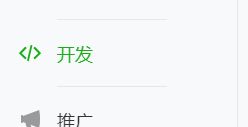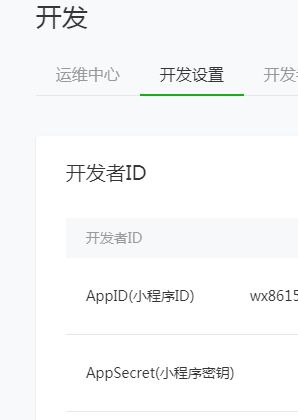微信小程序 java服务器发送通知给用户 全流程 (获取openid 获取formid)
本文写的比较简单,只是一个简单的实现,如有错误,欢迎大家指出,本文为个人学习笔记,只供参考。
如果成功了给句评论,或来个赞呗!
本文大致分为三个内容:
一、注册小程序
二、微信小程序开发代码
三、java客户端代码
一、注册小程序
后台网站
https://mp.weixin.qq.com/
主要是需要以下几个信息:
1、模板id
2、AppId、AppSecret
这里的appid、appsecret也要记录下来,有用。
二、微信小程序代码
有好多同学,代码都对,就是收不到,就是这个问题:
在创建程序时:

看见闪亮亮的大字了没?????appid,用你之前注册的!
主要通过代码获取以下几个信息
1、openid
openid是一个用户对应一个小程序唯一的id。
这么说吧,一个人有好几把钥匙,但能开家大门的就那么一把。
明白了吧。
.js中的代码
wx.login({
// 获取code
success: function(res) {
var code = res.code
console.log(code)
wx.request({
url: 'https://api.weixin.qq.com/sns/jscode2session?appid=wx8615f70ac078c2fa&secret=33de81cca94b3efa918e4e7094362dd9&js_code=' + code + '&grant_type=authorization_code',
method: "GET",
data: {},
header: {
'content-type': 'application/json'
},
success: function(res) {
var openid = res.data.openid //返回openid
console.log(openid)
}
})
}
})
2、formid
这个是你想发通知的必要信息。
微信小程序不允许程序给个人主动发消息,都是用户要求的,如果用户说:我不知道啊? 那就是在代码里嵌入了表单提交。
一次表单提交,产生一个formid,然后这个formid就没用了。
想下次发提醒,那你就再提交一个表单申请。
.wxml中的代码
.js中的代码
form_submit(e) {
console.log(e.detail.formId)//formid
}
三、java中代码
/**
* 微信常量
* @Author: chu qiao
* @CreateDate: 2018/8/17 18:11
*/
public interface Wechat {
/**小程序唯一标识*/
String APPID = "这里填你的appid";//这里填你的appid
/**小程序的 app secret*/
String APPSECRET = "这里填你的appsecret";//这里填你的appsecret
/**默认*/
String GRANTTYPE = "authorization_code";
/**根据code获取sessionKey和openId的url*/
String WX_CODE2OPENID_URL = "https://api.weixin.qq.com/sns/jscode2session";
/**获取access_token*/
String ACCESS_TOKEN = "https://api.weixin.qq.com/cgi-bin/token";
/**获取二维码图片*/
String WXACODEUNLIMIT = "https://api.weixin.qq.com/wxa/getwxacodeunlimit";
String SEND_TEMPLATE_MESSAGE = "https://api.weixin.qq.com/cgi-bin/message/wxopen/template/send?access_token=";
}
实体类
/**
* 发送模板消息
* @Author: chu qiao
* @CreateDate: 2018/9/30 16:21
*/
public class sendTemplateMessage {
private String touser; //接收者(用户)的 openid
private String template_id; //所需下发的模板消息的id
private String page; //点击模板卡片后的跳转页面,仅限本小程序内的页面。支持带参数,(示例index?foo=bar)。该字段不填则模板无跳转。
private String form_id; //表单提交场景下,为 submit 事件带上的 formId;支付场景下,为本次支付的 prepay_id
private Map data; //模板内容,不填则下发空模板
private String emphasis_keyword; //模板需要放大的关键词,不填则默认无放大
public String getTouser() {
return touser;
}
public void setTouser(String touser) {
this.touser = touser;
}
public String getTemplate_id() {
return template_id;
}
public void setTemplate_id(String template_id) {
this.template_id = template_id;
}
public String getPage() {
return page;
}
public void setPage(String page) {
this.page = page;
}
public String getForm_id() {
return form_id;
}
public void setForm_id(String form_id) {
this.form_id = form_id;
}
public Map getData() {
return data;
}
public void setData(Map data) {
this.data = data;
}
public String getEmphasis_keyword() {
return emphasis_keyword;
}
public void setEmphasis_keyword(String emphasis_keyword) {
this.emphasis_keyword = emphasis_keyword;
}
}
public class TemplateData {
private String value;
public String getValue() {
return value;
}
public void setValue(String value) {
this.value = value;
}
public TemplateData(String value) {
this.value = value;
}
public TemplateData() {
}
}
public class Token {
private Token() {}
private String token;
private String accessToken;
private long expiryTime;
private static Token instance = new Token();
public static Token getInstance() {
return instance;
}
public String getAccessToken() {
return accessToken;
}
public void setAccessToken(String accessToken) {
this.accessToken = accessToken;
}
public long getExpiryTime() {
return expiryTime;
}
public void setExpiryTime(long expiryTime) {
this.expiryTime = expiryTime;
}
public String getToken() {
return token;
}
public void setToken(String token) {
this.token = token;
}
}
public class UrlUtils {
private static final Logger log = LoggerFactory.getLogger(UrlUtils.class);
/**
* 向指定URL发送GET方法的请求
* @param url 发送请求的URL
* @param param 请求参数,请求参数应该是 name1=value1&name2=value2 的形式。
* @return URL 所代表远程资源的响应结果
*/
public static String sendGet(String url, String param) {
String result = "";
BufferedReader in = null;
try {
String urlNameString = url + "?" + param;
URL realUrl = new URL(urlNameString);
// 打开和URL之间的连接
URLConnection connection = realUrl.openConnection();
// 设置通用的请求属性
connection.setRequestProperty("accept", "*/*");
connection.setRequestProperty("connection", "Keep-Alive");
connection.setRequestProperty("user-agent",
"Mozilla/4.0 (compatible; MSIE 6.0; Windows NT 5.1;SV1)");
// 建立实际的连接
connection.connect();
// 获取所有响应头字段
Map> map = connection.getHeaderFields();
// 遍历所有的响应头字段
// for (String key : map.keySet()) {
// System.out.println(key + "--->" + map.get(key));
// }
// 定义 BufferedReader输入流来读取URL的响应
in = new BufferedReader(new InputStreamReader(
connection.getInputStream()));
String line;
while ((line = in.readLine()) != null) {
result += line;
}
} catch (Exception e) {
log.error("发送GET请求出现异常!" + e);
e.printStackTrace();
}
// 使用finally块来关闭输入流
finally {
try {
if (in != null) {
in.close();
}
} catch (Exception e2) {
e2.printStackTrace();
}
}
return result;
}
/**
* 向指定 URL 发送POST方法的请求
* @param url 发送请求的 URL
* @param paramMap 请求参数
* @return 所代表远程资源的响应结果
*/
public static String sendPost(String url, Map paramMap) {
PrintWriter out = null;
BufferedReader in = null;
String result = "";
String param = "";
Iterator it = paramMap.keySet().iterator();
while (it.hasNext()) {
String key = it.next();
param += key + "=" + paramMap.get(key) + "&";
}
try {
URL realUrl = new URL(url);
// 打开和URL之间的连接
URLConnection conn = realUrl.openConnection();
// 设置通用的请求属性
conn.setRequestProperty("accept", "*/*");
conn.setRequestProperty("connection", "Keep-Alive");
conn.setRequestProperty("Accept-Charset", "utf-8");
conn.setRequestProperty("user-agent", "Mozilla/4.0 (compatible; MSIE 6.0; Windows NT 5.1;SV1)");
// 发送POST请求必须设置如下两行
conn.setDoOutput(true);
conn.setDoInput(true);
// 获取URLConnection对象对应的输出流
out = new PrintWriter(conn.getOutputStream());
// 发送请求参数
out.print(param);
// flush输出流的缓冲
out.flush();
// 定义BufferedReader输入流来读取URL的响应
in = new BufferedReader(new InputStreamReader(conn.getInputStream(), "UTF-8"));
String line;
while ((line = in.readLine()) != null) {
result += line;
}
} catch (Exception e) {
log.error(e.getMessage(), e);
}
//使用finally块来关闭输出流、输入流
finally {
try {
if (out != null) {
out.close();
}
if (in != null) {
in.close();
}
} catch (IOException ex) {
ex.printStackTrace();
}
}
return result;
}
}
public class MyTest {
/**
* 发送模板消息sendTemplateMessage
* 小程序模板消息,发送服务通知
* @param touser 接收者(用户)的 openid
* @param template_id 所需下发的模板消息的id
* @param page 点击模板卡片后的跳转页面,仅限本小程序内的页面。支持带参数,(示例index?foo=bar)。该字段不填则模板无跳转。
* @param formid 表单提交场景下,为 submit 事件带上的 formId;支付场景下,为本次支付的 prepay_id
* @return
*/
public static JSONObject sendTemplateMessage(String touser, String template_id, String page, String formid, Map map){
String accessToken = getAccessToken();
sendTemplateMessage sendTemplateMessage = new sendTemplateMessage();
//拼接数据
sendTemplateMessage.setTouser(touser);
sendTemplateMessage.setTemplate_id(template_id);
sendTemplateMessage.setPage(page);
sendTemplateMessage.setForm_id(formid);
sendTemplateMessage.setData(map);
sendTemplateMessage.setEmphasis_keyword("");
String json = JSONObject.toJSONString(sendTemplateMessage);
String ret = sendPost(Wechat.SEND_TEMPLATE_MESSAGE+accessToken, json);
return JSON.parseObject(ret);
}
public static String getAccessToken(){
String param = "grant_type=client_credential&appid="+Wechat.APPID+"&secret="+Wechat.APPSECRET;
String result = UrlUtils.sendGet(Wechat.ACCESS_TOKEN,param);
JSONObject demoJson = JSONObject.parseObject(result);
String accessToken = demoJson.getString("access_token");
String expiresIn = demoJson.getString("expires_in");
Token token = Token.getInstance();
token.setAccessToken(accessToken);
//过期时间的毫秒数
token.setExpiryTime(System.currentTimeMillis()+1000*60*100L);
return accessToken;
}
/**
* 发送post请求 json格式
* @param url
* @param param
* @return
*/
public static String sendPost(String url, String param) {
PrintWriter out = null;
BufferedReader in = null;
String result = "";
try {
URL realUrl = new URL(url);
// 打开和URL之间的连接
URLConnection conn = realUrl.openConnection();
// 设置通用的请求属性
conn.setRequestProperty("Accept", "application/json");
conn.setRequestProperty("Content-Type", "application/json");
// 发送POST请求必须设置如下两行
conn.setDoOutput(true);
conn.setDoInput(true);
// 获取URLConnection对象对应的输出流
out = new PrintWriter(conn.getOutputStream());
// 发送请求参数
out.print(param);
// flush输出流的缓冲
out.flush();
// 定义BufferedReader输入流来读取URL的响应
in = new BufferedReader(
new InputStreamReader(conn.getInputStream()));
String line;
while ((line = in.readLine()) != null) {
result += line;
}
} catch (Exception e) {
System.out.println("发送 POST 请求出现异常!"+e);
e.printStackTrace();
}
//使用finally块来关闭输出流、输入流
finally{
try{
if(out!=null){
out.close();
}
if(in!=null){
in.close();
}
}
catch(IOException ex){
ex.printStackTrace();
}
}
return result;
}
public static void main(String[] args) {
Map map = new HashMap<>();
//map.put("keyword1",new TemplateData("123"));
//map.put("keyword2",new TemplateData("321"));
//map.put("keyword3",new TemplateData("aaa"));
//map.put("keyword4",new TemplateData("bbb"));
//不是创建模板了么,模板几个参数map.put你就放几个
JSONObject js = sendTemplateMessage("放用户的openid", "放模板id", “”", "放formid",map);
System.out.println(js);
}
}
搞定!!!
本文也是参考其他人,大家都是为了学习~



